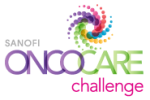 Amersfoort, 7 december 2015 – Patiënten met uitgezaaide dikkedarmkanker willen samen met hun arts een weloverwogen behandelkeuze maken. Informatie over behandelingen en bijwerkingen is echter vaak complex. Daarnaast blijkt dat de helft van de patiënten slechts in beperkte mate onthoudt wat er in de spreekkamer wordt gezegd.
Amersfoort, 7 december 2015 – Patiënten met uitgezaaide dikkedarmkanker willen samen met hun arts een weloverwogen behandelkeuze maken. Informatie over behandelingen en bijwerkingen is echter vaak complex. Daarnaast blijkt dat de helft van de patiënten slechts in beperkte mate onthoudt wat er in de spreekkamer wordt gezegd.
Voor inhoudelijke ondersteuning en om emotionele barrières bij de behandelkeuze te doorbreken ontwikkelen de Maag Lever Darm Stichting en ZorgKeuzeLab daarom in samenwerking met patiënten en vooraanstaande medisch oncologen de keuzehulp. Een interactieve tool die ondersteunt bij het kiezen van de best passende behandeling.
Nieuwe tool moet emotionele barrières in behandeltraject doorbreken
Veel patiënten slaan nu om verschillende redenen dicht tijdens het gesprek met de arts, onder andere doordat er zo veel informatie die op hen afkomt. De keuzehulp biedt patiënten objectieve informatie over de mogelijke behandelingen en bijwerkingen, die als een basis en naslagwerk kan dienen voor het gesprek tussen arts en patiënt. Daarnaast bestaat de keuzehulp uit stellingen, die kunnen bijdragen aan het maken van een keuze afgestemd op de individuele patiënt. Miriam Koopman, één van de drie oncologen: ‘Bij iedere behandeling voor uitgezaaide dikkedarmkanker staan patiënten voor hele moeilijke keuzes. Welke bijwerkingen wil iemand accepteren? Wat vinden zij belangrijk voor hun kwaliteit van leven? Die keuzes kun je het beste maken wanneer je volledig bent geïnformeerd. De keuzehulp helpt arts en patiënt daarbij.’
Door de keuzehulp krijgt een patiënt meer grip op de behandelkeuze. Meer grip zorgt uiteindelijk voor minder spijt, ongeacht het resultaat van de behandeling. Koopman: ‘Gezamenlijke besluitvorming is heel belangrijk. Patiënten willen geen standaard behandelprotocol volgen en zo veel mogelijk zelf de regie houden met een behandelplan afgestemd op hun eigen situatie en wensen.’

Ontwikkelteam dikkedarmkanker keuzehulp
Patiënt hoort liever wat wél haalbaar is.
Uit het behoeftenonderzoek, dat voor de ontwikkeling van de keuzehulp is gehouden, blijkt dat patiënten vaker willen horen wat in hun situatie nog wél haalbaar is. De prognose van hun levensverwachting wordt door sommige patiënten zelfs als irrelevant gezien. Koopman: ‘Patiënten geven aan te willen weten wat de diagnose en behandelopties voor hun kwaliteit van leven betekenen, en het liefst zo praktisch mogelijk. Bijvoorbeeld of ze nog kunnen zwemmen met hun kind, kunnen fietsen of de sauna bezoeken. Na de diagnose willen ze vooral weten hoe het leven nog zo normaal mogelijk verder kan verlopen met of zonder behandeling.’
Vanaf 2016 in ziekenhuizen
De uitkomsten van het behoeftenonderzoek worden gebruikt om de keuzehulp verder te ontwikkelen. Naast een professionele versie, voor artsen in het ziekenhuis, wordt er ook een consumentenversie ontwikkeld. Die biedt iedereen die hieraan behoefte heeft informatie waardoor hij of zij de regie kan nemen over de behandeling. De Maag Lever Darm Stichting en ZorgKeuzeLab gaan een langdurig samenwerkingsverband aan voor de ontwikkeling en implementatie van de keuzehulp. Naast Dr. Miriam Koopman zijn de medisch oncologen Dr. Jan Willem de Groot en Dr. Judith de Vos-Geelen bij de ontwikkeling betrokken. De eerste zorginstellingen kunnen vanaf maart 2016 gebruik maken van de keuzehulp.
Financiering
De keuzehulp is een initiatief van de Maag Lever Darm Stichting. De stichting levert naast inhoudelijke kennis een financiële bijdrage. Daarnaast krijgt de keuzehulp financiële steun van Roche, Merck, Amgen, Sanofi en Stichting Hetty Odink. ZorgKeuzeLab levert naast de ontwikkeling ook een financiële bijdrage.
Gerelateerde artikelen
Op 23 november vond de kick-off bijeenkomst plaats van het project ‘Kiezen, dat doen we hier samen!’ in het Elisabeth-Tweesteden Ziekenhuis (ETZ) Tilburg. Het project heeft als doel om Shared Decision Making (SDM) in de praktijk te implementeren met ondersteuning van een drietal keuzehulpen.
Prof. dr. Bart Berden, voorzitter Raad van Bestuur van het ETZ, onderschreef de noodzaak om in de zorgverlening een minder bevoogdende rol te spelen; de zorgverlener krijgt steeds meer de rol van counsellor, bijvoorbeeld bij het maken van keuzes. Ook Herman Bleekendaal, lid van de ETZ cliëntenraad, ziet de toegevoegde waarde van de keuzehulpen. ‘Je hebt maar één lijf en er is maar één iemand die daar over gaat. en dat ben jezelf. Dat betekent dat je verantwoordelijkheid moet nemen voor de keuzes die jou aangaan. Een keuzehulp helpt daarbij.’
Ziekenhuis samen met professionals in de lead
Het ETZ is voornemens met succesvolle implementatie voorloper zijn binnen Nederland en wil graag stappen zetten om ziekenhuis-brede implementatie van SDM te faciliteren voor haar artsen. Passend bij de cultuur van het ziekenhuis wil zij graag samen met de medische staf dit proces regisseren: "Ziekenhuis samen met professionals in de lead".
SDM helpt de patiënt om aan te geven wat voor hem/haar belangrijk is bij de behandelkeuze. De patiënt weet daarnaast beter wat de consequenties zijn van de behandeling waarvoor hij samen met zijn arts kiest. Het ETZ loopt met deze ontwikkelingen landelijk voorop.
De ETZ projectgroep gaat i.s.m. het ZorgKeuzeLab een half jaar de effecten van de keuzehulpen meten en vervolgens evalueren. De uitkomst moet in de zomer bekend zijn. Daarnaast kunnen we nog een symposium in 2016 over dit onderwerp verwachten. ‘Ik hoop dat er snel een inktvlek in gang wordt gezet in de organisatie.’ aldus Berden. Paul Kil vult dit aan met: ‘De artsen moeten dit initiëren’.
Hoe werkt het in de praktijk?
De behandelend arts reikt de patiënt een receptbrief met een inlogcode uit om zelf op een rustig moment de keuzehulp in te vullen. Aan de hand van stellingen kan de patiënt zelf aangeven wat persoonlijk belangrijke overwegingen zijn om wel of niet voor een bepaalde behandeling te kiezen. In het ziekenhuis bespreekt de behandelend arts de resultaten vervolgens met de patiënt. Daardoor ontstaat een gelijkwaardige relatie tussen beiden. Uiteindelijk wordt een gezamenlijk besluit genomen over de verdere behandeling, een besluit waar de patiënt dan ook zelf achter staat.
Keuzehulp uitproberen?
Bent u een chirurg of verpleegkundige en wilt u de Borstkanker keuzehulp of Prostaatkanker keuzehulp kostenloos uitproberen in uw dagelijkse praktijk? Bekijk dan hier de mogelijkheden of neem contact op met Regina The via regina@zorgkeuzelab.nl of 06-24220053
Gerelateerd artikel
 Dr. Paul Kil en zijn team hebben donderdag de Onco Care Challenge 2015 gewonnen met hun project waarin er een uro-oncologische samenwerking is voor de behandeling van castratie resistente prostaatkanker. Als prijs ontvangt het team 5000 euro om het project uit te voeren.
Dr. Paul Kil en zijn team hebben donderdag de Onco Care Challenge 2015 gewonnen met hun project waarin er een uro-oncologische samenwerking is voor de behandeling van castratie resistente prostaatkanker. Als prijs ontvangt het team 5000 euro om het project uit te voeren.
Patiënten met uitgezaaide prostaatkanker krijgen in eerste instantie vaak een hormonale behandeling. Als dit niet aanslaat kijkt het behandelend team naar andere behandelopties, variërend van afwachten tot chemotherapie.
Met het project wordt keuzeondersteuning ontwikkeld. Deze bestaat uit een instrument om de kwetsbaarheid van patiënten met prostaatkanker goed te kunnen beoordelen. Op basis van de score en de persoonlijke voorkeuren van de patiënt kan vervolgens de best passende behandeloptie worden gekozen.
 Vaak blijken de prioriteiten bij de behandelaars anders te zijn dan die van patiënten. Het doel is om keuzeondersteuning te ontwikkelen die het eenvoudiger maakt om te bepalen wat de patiënt wil, maar ook wat hij nog kan ondergaan om zijn eigen doelen te bereiken.
Vaak blijken de prioriteiten bij de behandelaars anders te zijn dan die van patiënten. Het doel is om keuzeondersteuning te ontwikkelen die het eenvoudiger maakt om te bepalen wat de patiënt wil, maar ook wat hij nog kan ondergaan om zijn eigen doelen te bereiken.
Gerelateerde artikelen:
 In november vinden jaarlijks extra activiteiten plaats om geld in te zamelen voor programma's gericht op onder andere prostaatkanker. Ook ZorgKeuzeLab heeft een speciale Movember actie. Bent u patiënt met prostaatkanker? Of bent u als zorgprofessional betrokken bij de behandeling van patiënten met prostaatkanker? Neem dan contact op om onze prostaatkanker keuzehulp uit te proberen.
In november vinden jaarlijks extra activiteiten plaats om geld in te zamelen voor programma's gericht op onder andere prostaatkanker. Ook ZorgKeuzeLab heeft een speciale Movember actie. Bent u patiënt met prostaatkanker? Of bent u als zorgprofessional betrokken bij de behandeling van patiënten met prostaatkanker? Neem dan contact op om onze prostaatkanker keuzehulp uit te proberen.
Uit onderzoek blijkt dat een derde van de prostaatkanker patiënten ontevreden is met de ontvangen informatie rondom de behandelkeuze. Daarnaast hebben deze patiënten ook een slechtere kwaliteit van leven. Patiënten hebben behoefte aan eerlijke, transparante informatie over behandelopties. Daarom heeft het ZorgKeuzeLab in nauwe samenwerking met Dr. Paul Kil en zijn team keuzehulpen ontwikkeld voor onder andere gelokaliseerd prostaatkanker en castratie resistente prostaatkanker.
Actie Ziekenhuis Rivierenland
Met de actie 'PRO-snor = PROstaat' wordt bij ziekenhuis Rivierenland geld ingezameld om prostaatkankerpatiënten de keuzehulp aan haar patiënten te kunnen aanbieden. U kunt ook mee doen door uw snor te laten groeien. Op 24 november is er een heuse barbier aanwezig in het ziekenhuis om uw snor bij te knippen of weg te scheren. Er is beperkt plek dus meld u nu vast aan bij urologie@zrt.nl of 0344 - 67 4468.
De prostaatkanker keuzehulp uitproberen?
Voor patiënten
Bent u een patiënt met gelokaliseerd prostaatkanker en wilt u eens gebruik maken van de prostaatkanker keuzehulp? Neem contact op met Annette van den Berg via annette@zorgkeuzelab.nl of 06 5055 3300.
Voor urologen en oncologieverpleegkundigen
Of bent u uroloog of oncologieverpleegkundige en wilt u de prostaatkanker keuzehulp kosteloos uitproberen in uw dagelijkse praktijk? Bekijk hier de mogelijkheden en neem contact op met Regina The via regina@zorgkeuzelab.nl of 06 2422 0053.
Gerelateerde artikelen